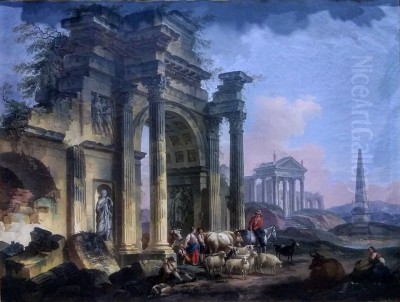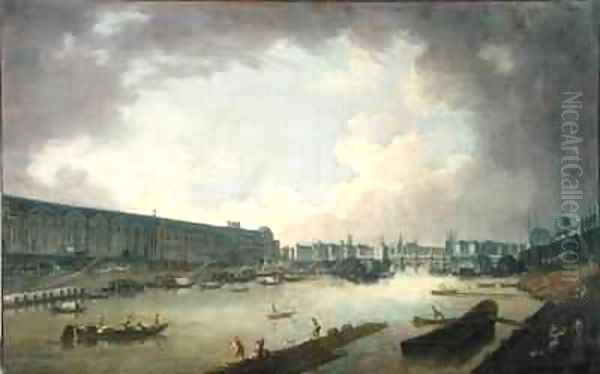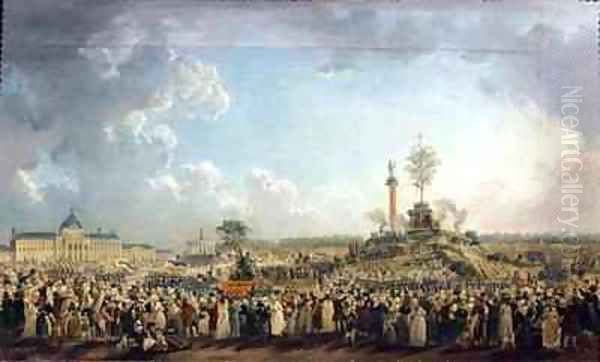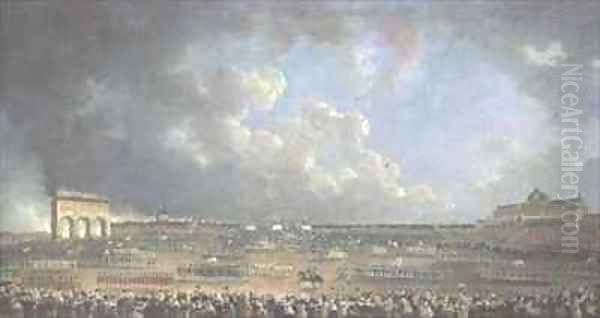
Pierre Antoine Demachy stands as a significant figure in 18th-century French art, celebrated primarily for his detailed and evocative paintings of architectural landscapes. Born in the heart of Paris, the city that would become his lifelong muse, Demachy dedicated his career to capturing its evolving urban fabric, its grand structures, and the historical moments that unfolded within its streets. His work provides not only aesthetic pleasure but also an invaluable visual record of Paris during a period of profound transformation.
Parisian Roots and Artistic Formation
Born on September 17, 1723, Pierre Antoine Demachy was a true Parisian, living and working in the city until his death on September 10, 1807. His artistic journey began formally around 1754 when he entered the tutelage of Giovanni Niccolò Servandoni. Servandoni, himself a Florentine architect and painter who had settled in Paris, brought with him the influence of Italian stage design and architectural painting, having been a student of the renowned Italian veduta painter Giovanni Paolo Panini. This lineage undoubtedly shaped Demachy's own artistic inclinations.
Servandoni's expertise in both architecture and painting, particularly his skill in creating dramatic perspectives often seen in stage sets, provided Demachy with a strong foundation. This training instilled in him a deep understanding of spatial representation and architectural accuracy, elements that would become hallmarks of his own work. The influence of Panini, known for his views of Rome, both real and imagined (capricci), likely encouraged Demachy's interest in depicting grand structures and, occasionally, picturesque ruins.
Following his apprenticeship, Demachy pursued further studies within the academic system. Sources suggest he became recognized as an official painter, specializing in architectural subjects, around 1758. His expertise in perspective, a critical skill for architectural painting, was formally acknowledged when he was appointed Professor of Perspective at the prestigious Académie Royale de Peinture et de Sculpture. While some sources place this appointment in 1786, others suggest it may have been as early as 1768, highlighting his established reputation in this specialized field.
Style, Technique, and Influences

Demachy's artistic output is firmly rooted in the tradition of the veduta, or view painting, which gained immense popularity across Europe in the 18th century. However, he developed a distinctly French interpretation of the genre, focusing primarily on his native Paris rather than the Italian scenes favored by artists like Canaletto or Francesco Guardi. His style is characterized by a meticulous attention to architectural detail, a sophisticated handling of light and shadow, and a keen sense of atmosphere.
While accuracy was important, Demachy's paintings were not mere topographical records. He often infused his scenes with a picturesque sensibility, sometimes incorporating elements of fantasy or idealized arrangements. This might involve depicting buildings in a state of ruin, even if they were intact, or composing views that combined real landmarks in slightly altered configurations for dramatic effect. This blend of reality and imagination aligns him with contemporaries like Hubert Robert, who was also known for his romanticized depictions of ruins and landscapes.
His training under Servandoni and the indirect influence of Panini are evident in his compositional strategies and his fascination with monumental architecture. He often employed clear, structured perspectives to lead the viewer's eye into the scene, emphasizing the grandeur of Parisian buildings. His handling of light tends to be even and clear, illuminating details, though he was also capable of capturing specific atmospheric conditions, such as the play of clouds or the soft glow of moonlight, as seen in works like Architectural Sketch by Moonlight.
Demachy worked primarily in oil paint, but he also produced drawings and sketches. His oil sketches, like the famous study of clouds over the Louvre, demonstrate a looser, more painterly approach, capturing fleeting effects of light and atmosphere with remarkable freshness. These studies reveal a side of his practice focused on direct observation and the exploration of visual phenomena, complementing his more finished studio compositions.
Paris as Muse: The Urban Landscape
For Demachy, Paris was an inexhaustible source of inspiration. His long life spanned a period of significant architectural development and urban change in the city, and his paintings reflect this dynamic environment. He depicted well-known landmarks, bustling public squares, quiet side streets, and the banks of the Seine. His subjects ranged from the majestic facades of the Louvre and Notre Dame Cathedral to the lively activity of markets and public gatherings.

His residency was particularly conducive to his work. For a significant portion of his mature career, from approximately 1769 to 1806, Demachy was granted lodging within the Louvre Palace itself. This privilege, often extended to artists affiliated with the Academy, placed him at the very center of Parisian artistic and architectural life. Living within the Louvre provided him with immediate access to stunning views – both of the palace complex itself and of the surrounding city – which he frequently captured in his work.
Demachy's paintings often include small figures that animate the architectural settings. These figures, while secondary to the buildings, add a sense of scale and narrative interest. They depict Parisians from various walks of life engaged in everyday activities – strolling, conversing, working, or participating in public events. Through these details, Demachy's work transcends simple architectural representation to become a broader commentary on urban life in 18th-century Paris. He captured the city not just as a collection of stones, but as a living, breathing entity.
He was particularly adept at portraying the relationship between the built environment and the natural world. Skies play a significant role in his compositions, often filled with dynamic cloud formations that add drama and emotional resonance to the scenes below. His studies of clouds, like the one observed from his Louvre window, show a particular sensitivity to meteorological effects, anticipating later developments in landscape painting.
Documenting History: Revolution and Change
Beyond capturing the enduring monuments and daily life of Paris, Demachy also served as a visual chronicler of specific historical events, particularly those related to the French Revolution. Living and working through this tumultuous period, he witnessed firsthand the dramatic transformations and upheavals that reshaped French society and the Parisian landscape. His paintings offer valuable insights into how these events were experienced and commemorated.
One notable example is his depiction of the Fête de l'Unité et de l'Indivisibilité (Festival of Unity and Indivisibility), held on August 10, 1793, to celebrate the first anniversary of the storming of the Tuileries Palace and the new Republican constitution. Demachy's painting captures the elaborate, symbolic procession and ceremonies orchestrated by Jacques-Louis David, providing a vivid record of revolutionary pageantry set against the backdrop of familiar Parisian locations.
Earlier in his career, he also documented dramatic occurrences, such as the fire at the Foire Saint-Germain (St. Germain Fair) in 1762. His painting Foire St. Germain en Feu captures the chaos and spectacle of the event, demonstrating his ability to handle complex scenes involving numerous figures and dramatic lighting effects. These works underscore the role of artists like Demachy in recording contemporary history before the advent of photography.

His depictions of architectural demolition or alteration also reflect the changing city. Paris underwent significant urban planning projects during the 18th century, and Demachy sometimes recorded the process of destruction and construction, offering glimpses into the physical transformation of the capital. These works serve as important historical documents, preserving views of buildings or urban configurations that no longer exist.
Key Works Examined
Several works stand out as particularly representative of Demachy's oeuvre and artistic concerns.
Clouds above the Rooftops of the Louvre (c. 1769-1785): This small oil sketch on paper is perhaps one of his most admired works for its immediacy and focus on atmospheric effects. Painted from his own window in the Louvre, it depicts the chimneys and rooftops of the palace silhouetted against a dramatic sky filled with billowing clouds. It is celebrated for its free brushwork and its sensitive observation of light and air, showcasing a more intimate and observational aspect of his talent. It stands as a rare confirmed example of his oil sketch practice.
Foire St. Germain en Feu (1762): This painting demonstrates Demachy's skill in depicting dramatic events and complex scenes. It captures the intensity of the fire that ravaged the popular Parisian fair, with flames illuminating the night sky and crowds reacting in the foreground. The work combines architectural accuracy in the depiction of the fair structures with a dynamic rendering of the disaster, showcasing his ability to merge reportage with artistic composition.
Fête de l'Unité (1793): As mentioned earlier, this work is significant for its historical documentation of a key event during the French Revolution. Demachy meticulously renders the procession, the temporary monuments (like the Fountain of Regeneration), and the crowds gathered on the Champ de Mars. It exemplifies his role as a visual historian, capturing the specific iconography and atmosphere of the revolutionary period.
Architectural Sketch by Moonlight (c. 1780-1807): This title likely refers to a type of work Demachy produced, showcasing his interest in nocturnal scenes and the effects of moonlight on architecture. Such paintings often possess a romantic or melancholic quality, emphasizing the silhouettes of buildings and the interplay of deep shadows and subtle highlights. They highlight his versatility in capturing different moods and times of day.
These examples illustrate the range of Demachy's work, from intimate atmospheric studies and detailed architectural views to dramatic event paintings and historical records.
Relationships and Contemporaries
Demachy's artistic development and career were situated within a vibrant network of artists and architects in 18th-century Paris. His most formative relationship was undoubtedly with his teacher, Giovanni Niccolò Servandoni, whose own background linked Demachy to the Italian veduta tradition through Giovanni Paolo Panini. This lineage provided Demachy with a solid grounding in perspective and architectural representation.
Among his French contemporaries, Hubert Robert is perhaps the most frequently mentioned connection. Robert, also known for his landscapes and architectural views, particularly his romantic depictions of ruins, shared living quarters with Demachy in the Louvre for a period. While direct collaborative projects are not well-documented, it is clear they moved in the same artistic circles. Art historians note that Demachy may have had a lasting influence on Robert, suggesting an exchange of ideas and stylistic approaches between the two painters who both specialized in architectural subjects.
Demachy worked during a rich period in French art. He was a contemporary of major figures of the late Rococo and emerging Neoclassical movements. While his focus differed from the mythological or genre scenes of Jean-Honoré Fragonard or François Boucher, he shared the era's interest in refined technique and picturesque sensibilities. His work also coincided with the rise of Neoclassicism, championed by Jacques-Louis David, whose revolutionary pageants Demachy himself depicted.
His focus on architectural subjects naturally connected him to the prominent architects of his time, whose works often featured in his paintings. He depicted buildings designed or modified by figures like Ange-Jacques Gabriel (architect of the Place de la Concorde and the Petit Trianon) and Jacques-Germain Soufflot (architect of the Panthéon). His paintings provide valuable visual context for the architectural achievements of the era, complementing the visionary designs of contemporaries like Étienne-Louis Boullée and Claude-Nicolas Ledoux.
Furthermore, his landscape and cityscape focus places him in dialogue with other French view painters, such as the celebrated Claude-Joseph Vernet, known for his dramatic seascapes and landscapes, although Vernet's scope was often broader than Demachy's Parisian concentration. Comparisons can also be drawn with earlier French artists who depicted urban scenes, though Demachy's specialization in architectural views was particularly pronounced. Other artists active in the Academy during his time included figures like Jean-Baptiste Oudry, known for animal painting and still life. Demachy's career unfolded within this complex and dynamic artistic milieu.
Legacy and Influence
Pierre Antoine Demachy's legacy rests primarily on his contribution to French architectural painting and his invaluable visual documentation of 18th-century Paris. His works are appreciated for their technical skill, particularly their mastery of perspective and detailed rendering, as well as their ability to capture the specific atmosphere and character of the city. He successfully adapted the Italian veduta tradition to a French context, focusing on his native city with dedication and insight.
His paintings serve as crucial historical records. They document not only the appearance of buildings and streets – some of which have since been altered or destroyed – but also significant historical events, public life, and the urban transformations of his time. For historians of Paris, architecture, and the French Revolution, Demachy's work remains an indispensable resource.
While perhaps not as widely famous today as some of his contemporaries like Fragonard or David, Demachy holds a secure place in the history of French art. His paintings are housed in major museum collections, including the Louvre Museum and the Carnavalet Museum (the museum of the history of Paris), attesting to their recognized artistic and historical importance. His influence on other painters interested in architectural subjects, such as Hubert Robert, is also acknowledged.
It is important to note that while some sources (like those provided in the initial prompt) mistakenly associate the name "Demachy" with the later Pictorialist photography movement, this refers to a different individual, Robert Demachy (1859-1936). Pierre Antoine Demachy, the 18th-century painter, had no connection to photography. His influence lies squarely within the realm of painting and drawing.
Information regarding his personal life, beyond his professional appointments and residency, remains relatively scarce. Unlike some artists who left behind extensive letters or diaries, Demachy is known primarily through his artistic output and official records. No significant caches of personal anecdotes or unpublished private details have emerged to dramatically alter our understanding of the man behind the paintings.
Conclusion
Pierre Antoine Demachy was more than just a painter of buildings; he was a visual biographer of Paris. Through meticulous detail, skilled composition, and a sensitive eye for atmosphere, he captured the essence of the French capital during a pivotal century. His apprenticeship under Servandoni grounded him in the techniques of architectural representation, while his long career allowed him to witness and record profound urban and historical changes. From tranquil moonlit scenes to the dramatic spectacle of fires and revolutionary festivals, his canvases offer a rich and enduring portrait of 18th-century Parisian life. His work continues to be valued not only for its aesthetic qualities but also for its irreplaceable contribution to our understanding of the history and appearance of one of the world's great cities.